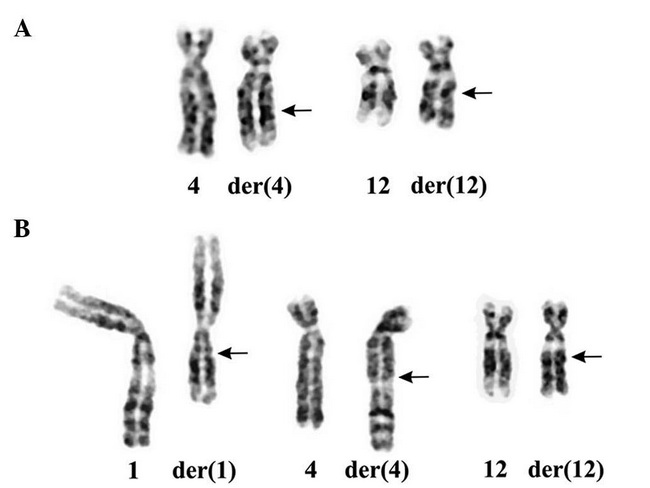Lipoma : Cytogenetics


Comments:
Lipoma Cytogenetics: Most lipomas have cytogenetic anomalies. The karyotype is usually pseudodiploid or near-diploid. The cytogenetic findings can be subdivided into 4 major groups:
- 65% of lipomas show structural rearrangements of 12q13-15. The most common of these is t(3;12)(q27-28;q13-15). Less commonly, the translocations involve 12q13-15 and other chromosomes, including 1p, 2p, 2q, 5q, 11q, and 12p. The image shows two additional translocations identified in lipomas. Case A had translocation t(4;12)(q27~28;q14~15), whereas Case B had a 3-way translocation t(1;4;12)(q21;q27~28;q14~15). Note 12q14-15 is involved in both cases.
- Most rearrangements target high mobility group AT-hook 2 (HMGA2) gene in 12q14.3
- 15% of lipomas show loss of material from 13q which has some overlap with spindle cell lipomas
- 5% show structural rearrangements of band 6p21, involving HMGA1 which is closely related to HMGA2
- 5% show supernumerary ring chromosomes; these cases are most likely well-differentiated subtypes of atypical lipomatous tumors. They are usually large, deep-seated tumors in older patients with a greater risk of relapse
- 5% of cases show a combination of these cytogenetic anomalies Image source: Agostini, A., Gorunova, L., Bjerkehagen, B., Lobmaier, I., Heim, S., & Panagopoulos, I. (2016). Molecular characterization of the t(4;12)(q27~28;q14~15) chromosomal rearrangement in lipoma. Oncology Letters, 12, 1701-1704. https://doi.org/10.3892/ol.2016.4834; used under Creative Commons Attribution-NonCommercial-NoDerivatives 4.0 International (CC BY-NC-ND 4.0) license.



